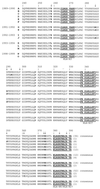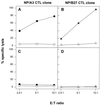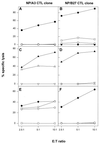Antigenic drift in the influenza A virus (H3N2) nucleoprotein and escape from recognition by cytotoxic T lymphocytes
- PMID: 10888619
- PMCID: PMC112197
- DOI: 10.1128/jvi.74.15.6800-6807.2000
Antigenic drift in the influenza A virus (H3N2) nucleoprotein and escape from recognition by cytotoxic T lymphocytes
Abstract
Viruses exploit different strategies to escape immune surveillance, including the introduction of mutations in cytotoxic T-lymphocyte (CTL) epitopes. The sequence of these epitopes is critical for their binding to major histocompatibility complex (MHC) class I molecules and recognition by specific CTLs, both of which interactions may be lost by mutation. Sequence analysis of the nucleoprotein gene of influenza A viruses (H3N2) isolated in The Netherlands from 1989 to 1999 revealed two independent amino acid mutations at the anchor residue of the HLA-B27-specific CTL epitope SRYWAIRTR (383 to 391). A R384K mutation was found in influenza A viruses isolated during the influenza season 1989-1990 but not in subsequent seasons. In the influenza season 1993-1994, a novel mutation in the same CTL epitope at the same position was introduced. This R384G mutation proved to be conserved in all influenza A viruses isolated from 1993 onwards. Both mutations R384K and R384G abrogated MHC class I presentation and allowed escape from recognition by specific CTLs.
Figures




References
-
- Apolloni A, Moss D, Stumm R, Burrows S, Suhrbier A, Misko I, Smidt C, Sculley T. Sequence variation of cytotoxic T cell epitopes in different isolates of Epstein-Barr virus. Eur J Immunol. 1992;22:183–189. - PubMed
-
- Bertoletti A, Sette A, Chisari F V, Penna A, Levrero M, De Carli M, Fiaccadori F, Ferrari C. Natural variants of cytotoxic epitopes are T-cell receptor antagonists for antiviral cytotoxic T cells. Nature. 1994;369:407–410. - PubMed
-
- Bertoletti A, Costanzo A, Chisari F V, Levrero M, Artini M, Sette A, Penna A, Giuberti T, Fiaccadori F, Ferrari C. Cytotoxic T lymphocyte response to a wild type hepatitis B virus epitope in patients chronically infected by variant viruses carrying substitutions within the epitope. J Exp Med. 1994;180:933–943. - PMC - PubMed
Publication types
MeSH terms
Substances
Associated data
- Actions
- Actions
- Actions
- Actions
- Actions
- Actions
- Actions
- Actions
- Actions
- Actions
- Actions
- Actions
- Actions
- Actions
- Actions
- Actions
- Actions
- Actions
- Actions
- Actions
- Actions
- Actions
- Actions
- Actions
- Actions
- Actions
- Actions
- Actions
- Actions
- Actions
LinkOut - more resources
Full Text Sources
Other Literature Sources
Molecular Biology Databases
Research Materials

